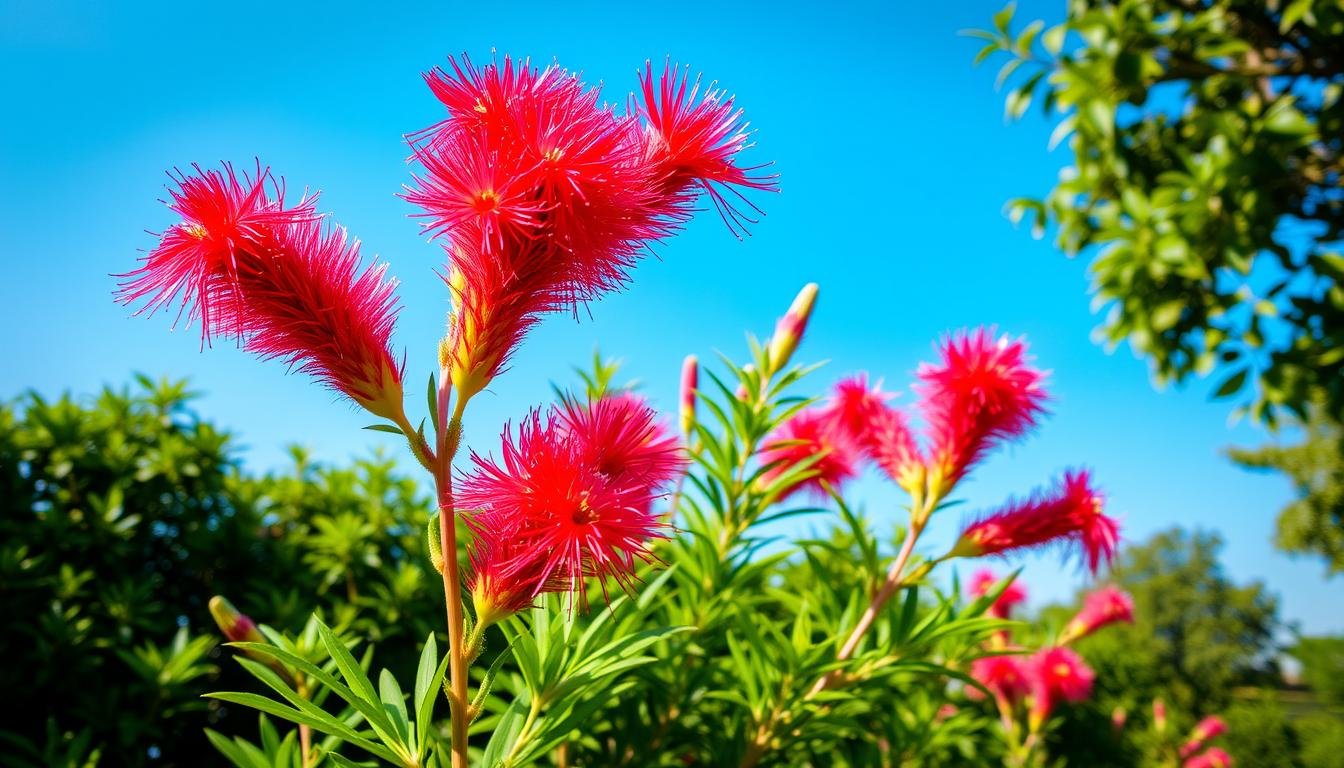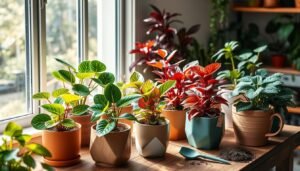The Bottle Brush Plant, known scientifically as Callistemon, is a standout evergreen shrub. It’s famous for its red bottlebrush flowers that look like traditional bottle brushes. These bright blooms are a favorite among garden lovers.
Being an Australian native, this plant adds beauty to your garden. It also helps attract pollinators, boosting your garden’s biodiversity. Its ability to thrive in different climates and its drought resistance make it perfect for easy gardening, mainly in warmer areas.
Key Takeaways
- Callistemon is an evergreen shrub known for its unique appearance.
- The red bottlebrush flowers attract pollinators, enriching your garden’s biodiversity.
- This Australian native thrives in various climates and is drought-tolerant.
- Ideal for low-maintenance landscaping, best for USDA zones 9-11.
- Works beautifully in garden beds or as container plants.
Introduction to the Bottle Brush Plant
The bottlebrush shrub is a standout in Australia’s flora, known for its bright, eye-catching flowers. It’s a favorite in gardens for its charm and ability to adapt. Its red flowers look like bottle brushes, drawing attention and admiration.
In USDA Hardiness Zones 8-11, this plant thrives, perfect for gardens and outdoor areas. It grows fast and strong, reaching up to 3 meters tall and 1.3 meters wide. Pruned right, it can stay narrow, ideal for small spaces.
This shrub brings beauty and supports local wildlife. It attracts butterflies and hummingbirds, boosting your garden’s ecological value. It needs regular watering and annual fertilizing in spring and summer. Its ability to bloom all year ensures your garden stays colorful and interesting.
The Unique Characteristics of Callistemon
Callistemon, also known as the bottle brush plant, is part of the Myrtaceae family. It’s known for its beautiful and fragrant flowers. This evergreen shrub adds color and greenery to gardens all year.
These shrubs can grow up to 30 feet tall. They come in different shapes, from upright to weeping.
Overview of the Myrtaceae Family
The Myrtaceae family includes many aromatic plants. They are loved for their essential oils and striking flowers. These plants thrive in various conditions, making them a favorite among gardeners.
They support ecosystems by providing habitats and food for pollinators. This boosts biodiversity.
Growth habits and forms of Bottle Brush Plants
Callistemon is an evergreen shrub that looks lush all year. Some varieties grow fast, reaching up to four feet tall quickly. For example, Callistemon ‘Cane’s Hybrid’ grows well with proper care.
It adapts to different soils and conditions. This makes it a versatile and beautiful addition to gardens.
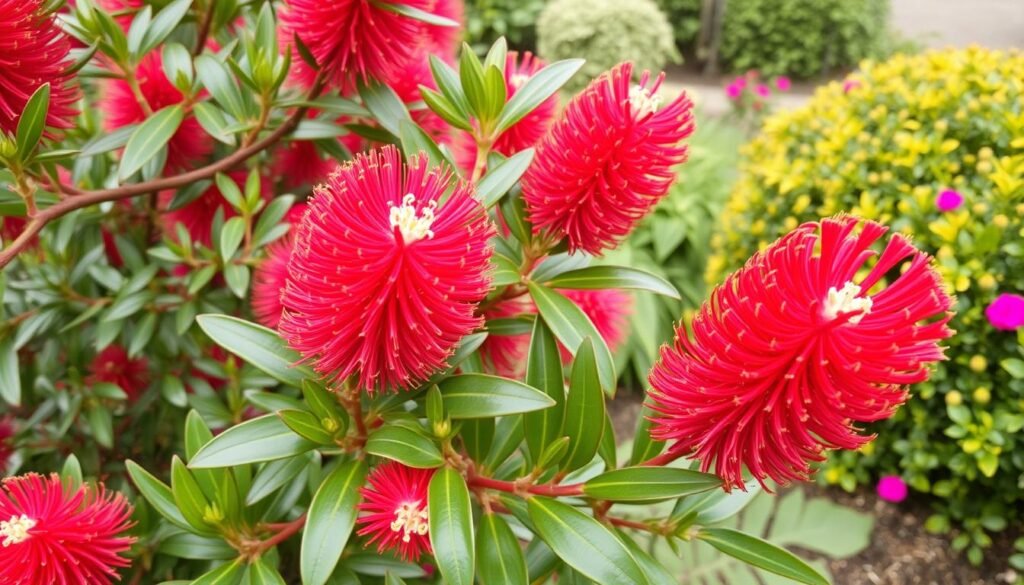
| Callistemon Variety | Height at Maturity | Spread at Maturity | Hardiness |
|---|---|---|---|
| Callistemon ‘Cane’s Hybrid’ | Up to 2.50 meters | Up to 1.50 meters | -12°C (USDA zone 8a) |
| Callistemon citrinus | Up to 5 meters | 3 meters | -10°C (USDA zone 9) |
| Callistemon viminalis | Up to 10 meters | 5 meters | -8°C (USDA zone 10) |
Callistemon is a popular choice for gardens. For more care and growing tips, visit here.
Red Bottlebrush Flowers: A Visual Delight
Red bottlebrush flowers are known for their bright and striking look. They can change any garden into a stunning place. These flowers bloom from spring to summer, showing off their colors and drawing eyes.
As they grow, their red colors change, making them even more interesting. This change adds to their beauty, making them a favorite in gardens.
Flowering seasons and color variations
Red bottlebrush flowers bloom from late spring to early summer. In warmer places, they might bloom into the fall. Their colors range from deep crimson to lighter reds.
This variety of colors makes any garden look better. It’s why many garden lovers choose bottlebrush plants.
Attracting pollinators with vibrant blooms
Red bottlebrush flowers are great for attracting bees and butterflies. Their nectar is a favorite food for pollinators. By planting these flowers, you make your garden more beautiful and help the environment.
These flowers help pollinate other plants. This is good for the health and growth of plants around them.
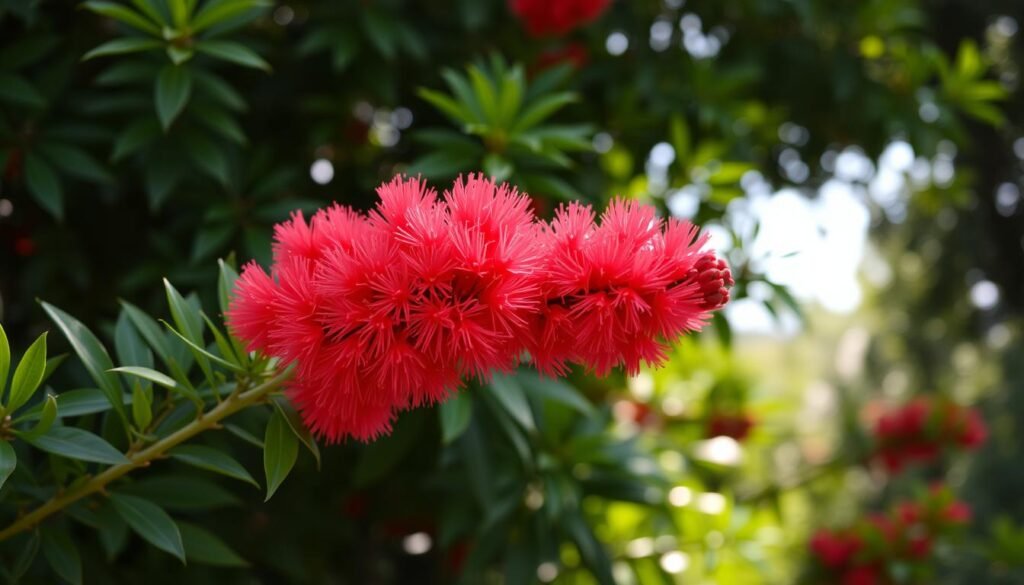
Choosing the Right Location for Your Bottle Brush Plant
Finding the perfect spot for your bottle brush plant is key for its growth and blooms. It loves sunlight and well-drained soil. Knowing its light and soil needs will help it thrive.
Light requirements and soil preferences
The bottle brush plant needs six to eight hours of sunlight daily. This helps it grow and bloom, attracting pollinators. It prefers neutral to slightly acidic soils with a pH of 5.5-7.0.
For the best growth, use a mix of two parts all-purpose potting mix and one part perlite. This mix drains well and keeps roots healthy. Choose a spot that meets these needs for a healthy plant.
Considerations for drainage and space
Good drainage is vital to avoid root rot. A spot that drains excess water well is best. Also, think about the plant’s mature size to avoid overcrowding.
In short, picking the right bottle brush planting location means understanding its light, soil, and space needs. Follow these tips for a lush, beautiful garden addition.
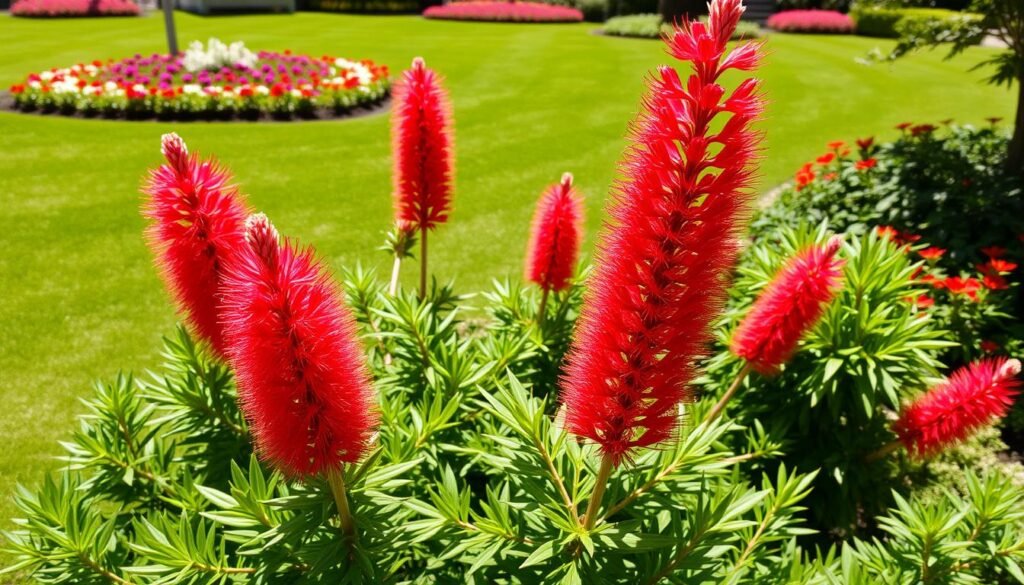
How to Plant a Bottle Brush Shrub
Planting a bottle brush shrub can make your outdoor space lively. A clear step-by-step guide helps the process go smoothly. This ensures your shrub grows well.
Step-by-step planting guide
First, pick a spot that gets full sun and has good drainage. This is key for your shrub’s health. Dig a hole that’s twice as wide and deep as the root ball.
Then, take the plant out of its pot and loosen any tight roots. Put the plant in the hole, making sure the root ball is level with the ground.
Fill the hole with soil, pressing it down to remove air pockets. Water well right after to help the soil settle around the roots.
Tips for ensuring the best growth
Watering and fertilizing right after planting are important. Water every other day for the first two weeks, then every three days for the next two. After that, water once a week, adjusting as the weather changes.
If it gets very hot and dry, water twice a week. Also, consider using a balanced fertilizer to give your shrub the nutrients it needs.
For more tips, check out this planting guide for extra care advice for your bottle brush plant.

Care and Maintenance of Bottle Brush Plants
Proper care and maintenance are key to keeping bottle brush plants healthy and looking great. Knowing how to water, fertilize, and prune them will help them bloom brightly all year round.
Watering and fertilization tips
Watering and fertilizing bottle brush plants right is important. When they’re new, they need water every day. But as they grow, they need less. For plants in pots, water them once a week, letting the soil dry a bit first.
It’s also important to adjust watering based on the weather. Make sure they get enough water when it’s hot, over 45 degrees Fahrenheit.
For fertilizing, use slow-release fertilizers with a 1-3-2 NPK ratio. These give plants the nutrients they need when they’re growing. You might need to replace them every six weeks. Organic options like compost or Milorganite can also help keep your plants healthy.
Pruning for optimal shape and growth
Pruning is vital for keeping your bottle brush plants looking good and growing well. Prune them after they’ve bloomed to encourage more flowers next year. Remove any dead or tangled branches to keep the air moving and the plant healthy.
For plants like the Dwarf Macarthur, regular pruning helps them grow bushy and round. This makes them look neat and tidy.
By following these watering and pruning tips, you’ll create the perfect home for your bottle brush plants. For more tips on caring for these lovely shrubs, check out detailed guides on bottle brush plant care.
Drought-Tolerant and Low-Maintenance Shrub
When picking shrubs for your garden, drought-tolerant ones like the bottle brush plant are great. They are very hardy and need little care. This is key in areas where saving water is important.
Choosing plants that do well in dry places helps the environment. It also makes your garden look better.
Benefits of drought resistance in landscaping
Drought-tolerant plants need much less water than others. This is good for those who want to help the planet and save time on gardening. These plants also add color and shape to your garden.
By using drought-resistant plants, you make your garden more eco-friendly. You also get to enjoy a lovely garden all year.
Comparative maintenance with other shrubs
The bottle brush plant needs less care than many other shrubs. Unlike plants that need a lot of water and food, these plants do well with little help. Here’s a comparison of different shrubs’ needs:
| Plant Type | Water Requirement | Maintenance Level |
|---|---|---|
| Bottle Brush | Low | Low |
| Lantana | Moderate | Medium |
| Rosemary | Low | Low |
| Coneflowers | Moderate | Medium |
| Bougainvillea | High | High |
The bottle brush plant is good for many climates. It’s a great choice for those who want a beautiful and easy-to-care-for garden. Check out drought-tolerant plants for your next garden project.
Landscaping Ideas with the Bottle Brush Plant
Adding the bottle brush plant to your outdoor space can make it look better and work better. It grows strong, making it perfect for privacy hedges or screens. These can turn your garden into a private spot, blocking noise and unwanted views.
It also brings color and attracts bees, butterflies, and birds. This makes your garden lively and inviting.
Using in privacy hedges and screens
The bottle brush shrub can create a natural barrier in your yard. Its red flowers add interest all year, making your yard a lively escape. Pair it with drought-tolerant plants for a garden that’s easy to care for.
For more ideas on what plants go well with the bottle brush, check out this resource.
How to highlight in garden design
Bottle brush plants can be the stars of your garden. Their unique flowers stand out against other plants. Use them as a focal point in your garden design.
Place them in borders or along paths to guide visitors. With the right planning, your garden will be a vibrant sanctuary. It will be a beautiful place that needs little care, making it a great addition to your yard.

